Robert Montgomery Bird
Robert Montgomery Bird (February 5, 1806, to January 23, 1854), a non-practicing physician who originally migrated to Philadelphia from Delaware, was most famous in his day for writing the plays that made Edwin Forrest the first American theatrical star. Bird’s The Gladiator (which set the stage for Kirk Douglas’s Spartacus and Russell Crowe’s Gladiator) was the first English-language play to be performed over a thousand times during its creator’s lifetime.
When Bird fell out with Forrest over suspiciously low royalty payments, he moved on to writing stories and novels, which flowed from his pen more easily than plays. His bloody romance about Kentucky, Nick of the Woods (1837), was a sensation that threatened to eclipse the more practiced and established James Fenimore Cooper’s Indian books. The novel is the first serial killer thriller, featuring a seemingly pacifist Quaker with a secret life and a bad grudge against Native Americans.
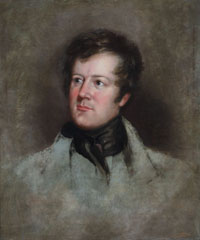
In Dr. Bird’s Sheppard Lee (1836), the title character has the ability to migrate his soul to another body at the moment of death. He assumes the identity of a succession of characters, providing a rich satirical portrait of Philadelphia life. But the novel’s supernatural elements, and Bird’s other preoccupations, place him squarely in territory first staked out by Charles Brockden Brown – an author he affected to despise.
Left: Mary Mayer Bird. Dr. Robert Montgomery Bird. Oil on canvas. (Philadelphia, ca. 1840). Loaned by Robert M. Bird. Bird’s wife was an accomplished painter, a student of the sought-after portraitist Thomas Sully. In this portrait of her husband she captured the wildly successful playwright and popular novelist, rather than the sometimes absent-minded non-practicing physician. As she wrote in her biographical memoir, Bird’s pockets were always crammed with notes on materials for fiction, which he found literally everywhere. He even tucked scraps of paper in his hat, and when he put it on to go out, they would spill on the floor.
“But these novels are much easier sorts of things, and immortalize one’s pocket much sooner. A tragedy takes, or should take, as much labour as two romances; . . . But to be set down in brotherhood with the asses that are doing these sort of things; and a hundred years hence, have my memory covered in three lines of a Biographical Dictionary! I had sooner be pickled with navy pork, and eaten as soon as I was preserved. . .
– Robert Montgomery Bird, 1831
_______________________________________________________________________________________
![[Nathaniel Currier]. Mr. J. Proctor in his Great Original Character of The Jibbenainosay (in Nick of the Woods). Lithograph with original hand color. (New York, ca. 1856).](images/th3.2.jpg) |
[Nathaniel Currier]. Mr. J. Proctor in his Great Original Character of The Jibbenainosay (in Nick of the Woods). Lithograph with original hand color. (New York, ca. 1856). Louisa Medina’s melodrama adaptation of Bird’s most popular novel Nick of the Woods held the stage at New York City venues such as Niblo’s Garden for decades. This poster by Currier (later of Currier & Ives) shows the title character (aka “Bloody Nathan” Slaughter, the Quaker driven by the Indian massacre of his family to serial revenge crimes), but it also conjures up another character in the story, Ralph Stackpole, the “ring-tailed squealer.” It was formerly in the collection of Neil K. Fitzgerald. |
| |
|
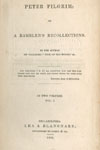 |
Robert Montgomery Bird. Peter Pilgrim: or A Rambler’s Recollections. (Philadelphia, 1838). |
| |
|
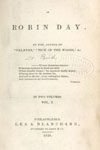 |
Robert Montgomery Bird. The Adventures of Robin Day. (Philadelphia, 1839). Besides psychological fiction, Bird experimented in other sub-genres of the Gothic. Robin Day, inspired by the Barnegat, New Jersey, “wreckers”, who lured ships aground to plunder their cargos, has blood-curdling murders and criminal conspiracies aplenty. Peter Pilgrim includes “The Legend of Merry the Miner,” features a Spanish prospector finally finds his gold, but also a mineful of petrified prehistoric predecessors who terrify him before he himself begins to turn to stone. |
| |
|
![[Robert Montgomery Bird]. Sheppard Lee. Written by Himself. (New York, 1836).](images/th3.5.jpg)
![[Robert Montgomery Bird]. Sheppard Lee. Written by Himself. (New York, 1836).](images/th3.6.jpg)
|
[Robert Montgomery Bird]. Sheppard Lee. Written by Himself. (New York, 1836). Bird was something of a proto-psychiatrist, and like Poe he was interested in areas where abnormal psychology and modern science crossed paths – mesmerism, shape-shifting, even (as it was thought of then) photography. In this book, the phenomenon du jour is metempsychosis – one man’s spirit migrates to other bodies, allowing Bird to explore and satirize Jacksonian identities: a broke dandy rogue; a miserly moneylender; a philanthropist mobbed and murdered by those he was trying to help; a pampered contented slave undone by reading an Abolitionist pamphlet. (Harriet Beecher Stowe appropriated the name of the slave for the title character of Uncle Tom’s Cabin.) |
| |
|
![[Edgar Allan Poe]. “Sheppard Lee.” In The Southern Literary Messenger (Richmond, September, 1836)](images/th3.7.jpg) |
[Edgar Allan Poe]. “Sheppard Lee.” In The Southern Literary Messenger (Richmond, September, 1836). Edgar Allan Poe reviewed Sheppard Lee very favorably in the great monthly magazine he then edited, The Southern Literary Messenger. Poe’s only complaint was he’d have preferred Sheppard to retain his own personality when he transmigrated to other roles. Since Poe later borrowed from it in “The Gold Bug” and other stories, Sheppard Lee must have been the sort of Gothic work that attracted Poe to Philadelphia, even though there is no record of the two men actually meeting. |
| |
|
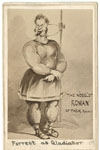
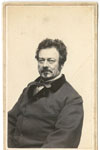
|
Charles D. Fredericks & Co. Edwin Forrest and J. Gurney & Son. Edwin Forrest as The Gladiator. Albumen photographic prints on cartes de visite. (New York, 1863). Bird’s play The Gladiator (1831) made actor Edwin Forrest (1806-1872) a superstar. He made a fortune and a global reputation performing it throughout his long career, but he cheated Bird out of all his royalties. It became the first English-language play to be performed over a thousand times during the lifetime of its playwright. This caricature of the overbearing Forrest in his favorite part was widely reproduced photographically at a point when audiences began to tire of his pompous style, also hinted at in this studio portrait. |
| |
|
![Robert Montgomery Bird. “M’Henry’s Art[icle] on Novel Writing.” Manuscript draft. (Philadelphia, 1834). Department of Special Collections, Van Pelt-Dietrich Library Center, University of Pennsylvania.](images/th3.10a.jpg) |
Robert Montgomery Bird. “M’Henry’s Art[icle] on Novel Writing.” Manuscript draft. (Philadelphia, 1834). Department of Special Collections, Van Pelt-Dietrich Library Center, University of Pennsylvania. In 1834 another novelist-doctor named James McHenry published an article in the American Quarterly Review on novel-writing. Bird loathed McHenry, and his article lavishly praised another novelist Bird despised, Charles Brockden Brown. Bird drafted a rejoinder, a telling diatribe against Brown, who had no imagination, no invention, no brilliance to construct a fable, no feeling, no savvy, no education. Essentially Brown described horror but did not inspire the feeling in his readers. Bird was annoyed that Brown discovered literary horror before he did. |
| |
|
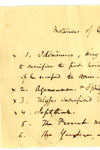 |
Robert Montgomery Bird. “Instances of Crimes committed by Fanatics as proofs of piety.” Manuscript note. (Philadelphia, late September to late October, 1831). Department of Special Collections, Van Pelt-Dietrich Library Center, The University of Pennsylvania. Like Brockden Brown and Dr. Benjamin Rush, Bird compiled lists of crimes, always storing up literary materials on which to found his own productions. Tucked into the manuscript of his play The Fanatick is this memo on classic cases of parents who thought human sacrifice a necessity. Conspicuously absent is the Daddy of Them All, the kindred Biblical account of Abraham and Isaac. |
| |
|
![[Robert Montgomery Bird]. “The Fanatick.” Manuscript. (Philadelphia, 1820s-1840s). Department of Special Collections, Van Pelt-Dietrich Library Center, The University of Pennsylvania.](images/th3.12.jpg) |
[Robert Montgomery Bird]. “The Fanatick.” Manuscript. (Philadelphia, 1820s-1840s). Department of Special Collections, Van Pelt-Dietrich Library Center, The University of Pennsylvania. With a new steel pen, young Bird tinkered with alternative names for a play idea that captivated him for almost two decades. None of the spelling variants of “Hallenvoehrling” or “Hallenvoring” worked. “Ardenheim”?- He tried “Leidenblied” – not too catchy either. “How about “Warlan”? No, better – “Warland.” Finally he called the main character “Wieland.” The plot is familiar: in a German castle an evil courtier throws his voice to play god and confuse Prince Wieland into divinely ordered sacrifice of his son. Obviously Brockden Brown had a profound effect on Bird. This play remains unfinished and unperformed. It would never have worked for Bird’s self-centered patron anyway; Edwin Forrest didn’t like to take off-stage prompts or orders from anyone – even God himself in the wings. |
| |
|
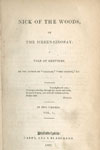 |
Robert Montgomery Bird, Nick of the Woods, or The Jibbenainosay. A Tale of Kentucky. (Philadelphia, 1837). Pacifist Quaker by day, serial killer of Red Men by night, Nathan Slaughter seems to be the first split-personality to hit American fiction. Indians have their own nicknames for “Bloody” Nathan – “Shawneewannaween” meaning “avenging curse on the Shawnees”; or, the “Jibbenainosay,” which seems to roughly translate as “really bad deal for Native Americans.” Mark Twain remembered the Jibbenainosay as the horror highlight of his childhood reading. As late as the 1940s, a series of “books for boys,” uniformly bound with a baseball player on each volume’s spine, included Nick. |
| |
|
![J[ohn].T[homas]. Haines. Nick of the Woods; or, The altar of revenge! A melo drama, in two acts. (London, not after 1857).](images/th3.14.jpg) |
J[ohn].T[homas]. Haines. Nick of the Woods; or, The altar of revenge! A melo drama, in two acts. (London, not after 1857). |
| |
|
![L[ouisa]. H. Medina. Nick of the Woods. A Drama, in Three Acts. (London, after 1843). Collection of Dr. Neil K. Fitzgerald.](images/th3.15.jpg) |
L[ouisa]. H. Medina. Nick of the Woods. A Drama, in Three Acts. (London, after 1843). Collection of Dr. Neil K. Fitzgerald. Playing a split personality really put an actor through his paces. In Medina’s melodrama version, he had to play Nick as Nathan Slaughter, Nick as Nick and the “Jibbenainosay,” Nick as the Avenger, Nick as Reginald Ashburne, and Nick as the “Spirit of the Waters” – switching back and forth most of the two hours and forty minutes on stage. Medina’s version was first produced at Manhattan’s raucous Bowery Theatre on February 20th, 1843. By 1857 it has been joined by an English version by J.T.Haines. Both were reprinted again and again into the 1940s. |
| |
|
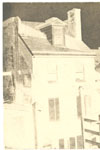
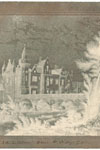
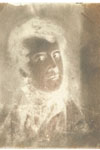
|
Robert Montgomery Bird. Paper Photographic negatives. (Philadelphia, early 1850s). Acquired in 1992 from Mr. Robert Montgomery Bird. With all his other accomplishments, Bird was also an important early experimenter in photography, specifically in the making of calotypes, or paper prints made from paper negatives. He took the same picture over and over and noted the different exposure times, light conditions, and developing formulas on the backs of both prints and negatives. Here are three of his paper negatives, ghostly images of the view from his studio at 10th and Filbert Streets, of a wood-engraved print of Abbotsford, the castellated Gothic home of Sir Walter Scott, and of his own oil portrait, the very one exhibited here.
|
NEXT: George Lippard >

![[Nathaniel Currier]. Mr. J. Proctor in his Great Original Character of The Jibbenainosay (in Nick of the Woods). Lithograph with original hand color. (New York, ca. 1856).](images/th3.2.jpg)


![[Robert Montgomery Bird]. Sheppard Lee. Written by Himself. (New York, 1836).](images/th3.5.jpg)
![[Robert Montgomery Bird]. Sheppard Lee. Written by Himself. (New York, 1836).](images/th3.6.jpg)
![[Edgar Allan Poe]. “Sheppard Lee.” In The Southern Literary Messenger (Richmond, September, 1836)](images/th3.7.jpg)


![Robert Montgomery Bird. “M’Henry’s Art[icle] on Novel Writing.” Manuscript draft. (Philadelphia, 1834). Department of Special Collections, Van Pelt-Dietrich Library Center, University of Pennsylvania.](images/th3.10a.jpg)

![[Robert Montgomery Bird]. “The Fanatick.” Manuscript. (Philadelphia, 1820s-1840s). Department of Special Collections, Van Pelt-Dietrich Library Center, The University of Pennsylvania.](images/th3.12.jpg)

![J[ohn].T[homas]. Haines. Nick of the Woods; or, The altar of revenge! A melo drama, in two acts. (London, not after 1857).](images/th3.14.jpg)
![L[ouisa]. H. Medina. Nick of the Woods. A Drama, in Three Acts. (London, after 1843). Collection of Dr. Neil K. Fitzgerald.](images/th3.15.jpg)


